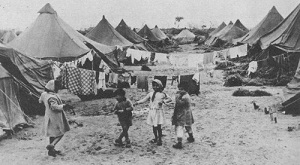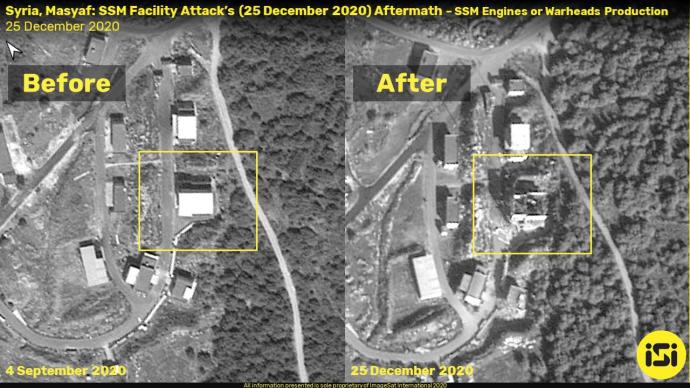 Znieść „Dzień Nakby
Znieść „Dzień Nakby
Bassem Eid
Tłumaczenie: Małgorzata Koraszewska
 Izraelski obóz przejściowy żydowskich uchodźców z krajów arabskich.
Izraelski obóz przejściowy żydowskich uchodźców z krajów arabskich.
Podczas wojny w 1948 roku, w brytyjskiej Palestynie Mandatowej żydowskie społeczności zostały wykorzenione i wygnane ze swoich domów w Gusz Ecjon i Atarot na dzisiejszym Zachodnim Brzegu przez dowodzony przez Brytyjczyków Transjordański Legion Arabski. Starożytna społeczność żydowska w Hebronie, gdzie znajduje się Makpela (Grota Patriarchów) – miejsce pochówku biblijnych przodków Abrahama, Izaaka i Jakuba – została już wygnana przez arabskie zamieszki w 1929 roku i władze brytyjskie uniemożliwiły jej powrót.
Na początku XX wieku populacja Bagdadu była w jednej trzeciej żydowska i podobnie jak dzisiejsze Wzgórze Świątynne, było tam wiele miejsc, które były wspólne dla wyznawców żydowskich i muzułmańskich, takie jak Grób proroka Ezechiela w al-Kifl, w którym od wieków jest i meczet, i synagoga. W 1941 roku, podczas krótkiego, wspieranego przez nazistów zamachu stanu, kierowanego przez Raszida Ali al-Gailaniego, antysemickiemu tłumowi pozwolono mordować i gwałcić członków społeczności żydowskiej w Bagdadzie w pogromie zwanym Farhud. Irak prześladował również swoją społeczność żydowską po uzyskaniu przez Izrael niepodległości. Do 1951 roku Izrael uratował drogą lotniczą prawie całą iracką populację żydowską w „ Operacji Ezra i Nehemiasz ”.
Społeczność żydowska w Jemenie została również uratowana przez rodzące się państwo żydowskie w latach 1948-49, w ciągu roku od uzyskania przez Izrael niepodległości, w „Operacji Skrzydła Orłów”. Według legendy, wielu jemeńskich Żydów nigdy wcześniej nawet nie widziało samolotu i potraktowało je jako dosłowne wypełnienie biblijnej obietnicy, że ci „którzy czekają na Pana […] wzniosą się na skrzydłach jak orły” (Izajasz 40:31).
W sumie ponad 850 000 Żydów zostało zmuszonych do ucieczki z krajów arabskich do Izraela, a potem ponad 70 000 Żydów z Iranu po rewolucji islamskiej w 1979 roku. Podobnie jak w Iraku, w Iranie znajdowały się miejsca wielowyznaniowe honorowane przez obie religie, takie jak Grobowiec Królowej Estery w Hamadanie w Iranie. W „Dniu Nakby” 2020 wandal podpalił części świątyni w wyniku prawdopodobnego przestępstwa z nienawiści.
Świat arabski doświadczył więcej wysiedleń niż niemal jakikolwiek inny region, o czym mogą świadczyć współczesne populacje uchodźców z Iraku i Syrii. Chociaż moja rodzina jest muzułmańska, urodziłem się w żydowskiej dzielnicy Starego Miasta w Jerozolimie, wówczas pod kontrolą Jordanii. W 1966 roku, kiedy miałem 8 lat, jordański rząd przeniósł moją rodzinę na północ od Jerozolimy do obozu uchodźców Szuafat. To rząd Jordanii, a nie rząd Izraela, uczynił mnie uchodźcą.
Różnica między kulturą palestyńską, w której celebruje się krzywdy, a kulturą izraelską, która idealizuje wolność, jest wyraźna. Na przykład populacja mniejszości chrześcijańskiej gwałtownie spadła na terytorium kontrolowanym przez Autonomię Palestyńską. W Betlejem zmniejszyła się z 84 procent do 22 procent tylko przez ostatnie dziesięć lat. Tymczasem partia oparta na islamie odgrywa kluczową rolę w obecnym rządzie Izraela, a izraelski Sąd Najwyższy powołał niedawno swojego pierwszego muzułmańskiego sędziego, Chaleda Kabuba.
Palestyńczycy powinni czcić nasze bogate dziedzictwo i, podobnie jak nasi żydowscy kuzyni, opłakiwać nasze straty. Ale teraz jest czas na wynegocjowanie pojednania, a nie na utrwalanie wielopokoleniowego poczucia krzywdy. „Dzień Nakby” jest częścią problemu mentalności ofiary, a nie przyszłościowym rozwiązaniem.
Pojednanie ma miejsce tylko wtedy, gdy obie strony cofają się o krok i uznają wspólne cierpienie. „Dzień Nakby” działa na odwrót. Podczas gdy Izrael trzykrotnie oferował Palestyńczykom pokój, godność i niezależność, Jaser Arafat zapoczątkował – a Mahmoud Abbas nie zdołał powstrzymać – brutalnej kultury drugiej intifady 2000-05 lat. Można uznać, że ustanowienie „Dnia Nakby” w 1998 roku było przygotowaniem do tej intifady.
Fetyszyzowanie samego istnienia Izraela jako katastrofy jest wypaczeniem, które rani nasze dzieci i prowadzi je do wojny i samobójczych zamachów bombowych. Prawie 1 milion Żydów na ziemiach islamskich stanęło w obliczu własnej Nakby po odzyskaniu przez Izrael niepodległości. Być może, gdyby więcej Palestyńczyków to zrozumiało, lepiej zrozumielibyśmy naszych izraelskich sąsiadów.
Musimy uczyć nasze dzieci o naszych sąsiadach, szukać zrozumienia i opowiadać się za pokojem. Przywódcy palestyńscy powinni zakończyć podżeganie przeciwko Izraelowi i Żydom – w tym szerzenie antysemickich stereotypów – w edukacji publicznej i mediach. Zamiast tego palestyńscy uczniowie i obywatele powinni poznać historię, radości i traumę naszych sąsiadów, Izraelczyków, z którymi mamy wiele wspólnego. W ten sposób możemy położyć podwaliny pod nowy Bliski Wschód, a miasta takie jak moje rodzinne Jerycho w Dolinie Jordanu mogą rozkwitnąć jako ośrodki międzynarodowej współpracy i handlu. Można to osiągnąć tylko wtedy, gdy nauczymy się rozumieć cierpienie naszych sąsiadów i przestaniemy wyolbrzymiać własne.
 Bassem Eid – Znany palestyński działacz na rzecz praw człowieka. Urodził się w 1958 roku w Jerozolimie wschodniej, gdzie nadal mieszka. Początkowo zajmował się naruszaniem praw człowieka przez żołnierzy Izraelskiej Armii Obronnej, stopniowo rozszerzając swoje zainteresowania o naruszania praw człowieka przez władze Autonomii Palestyńskiej i palestyńskie służby bezpieczeństwa. W 1996 roku założył organizację, Palestinian Human Rights Monitoring Group in 1996, która przerwała działalność w 2011 roku. Obecnie pracuje jako badacz i analityk w izraelskiej telewizji. Ujawnianie naruszeń praw człowieka przez Palestyńczyków wobec Palestyńczyków dostarczyło mu tysiące wrogów wśród sympatyków Palestyńczyków.
Bassem Eid – Znany palestyński działacz na rzecz praw człowieka. Urodził się w 1958 roku w Jerozolimie wschodniej, gdzie nadal mieszka. Początkowo zajmował się naruszaniem praw człowieka przez żołnierzy Izraelskiej Armii Obronnej, stopniowo rozszerzając swoje zainteresowania o naruszania praw człowieka przez władze Autonomii Palestyńskiej i palestyńskie służby bezpieczeństwa. W 1996 roku założył organizację, Palestinian Human Rights Monitoring Group in 1996, która przerwała działalność w 2011 roku. Obecnie pracuje jako badacz i analityk w izraelskiej telewizji. Ujawnianie naruszeń praw człowieka przez Palestyńczyków wobec Palestyńczyków dostarczyło mu tysiące wrogów wśród sympatyków Palestyńczyków.
Zawartość publikowanych artykułów i materiałów nie reprezentuje poglądów ani opinii Reunion’68,
ani też webmastera Blogu Reunion’68, chyba ze jest to wyraźnie zaznaczone.
Twoje uwagi, linki, własne artykuły lub wiadomości prześlij na adres:
webmaster@reunion68.com





